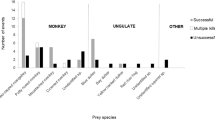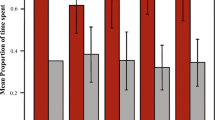Abstract
Predation can have major effects on vertebrate population dynamics, including predator–prey cycles that occur on multiple time scales when predators switch between preferred and alternative prey and changes in the abundance of preferred prey when the availability of alternative prey changes. Predation has been an important selective force in primate social evolution and may regulate some primate populations, but assessing its impact is often difficult. Chimpanzees (Pan troglodytes) provide opportunities for direct collection of data on predation intensity by following habituated predators because they regularly prey on a variety of vertebrates, including other primates. Chimpanzees mostly hunt red colobus monkeys (Procolobus spp.) wherever they live in sympatry. Previous reports have documented heavy predation on red colobus by chimpanzees in the unusually large Ngogo community, in Kibale National Park, Uganda, and have shown an apparent decline in the local red colobus population. Here, we update information on predation at Ngogo, give further evidence of a red colobus population decline, and ask whether the chimpanzees have made more effort to hunt alternative prey in response. Data collected between 1995 and 2014 show that the rate of alternative prey hunts has increased significantly, while the rate of red colobus hunts has declined. Predation on red colobus peaked in 2002; other prey have since accounted for significantly higher proportions of hunts and prey captures. The overall hunting rate has not changed significantly, but per capita meat availability has decreased because hunts of alternative prey lead to fewer captures than hunts of red colobus. The likelihood that the chimpanzees hunt red colobus on encounter has not changed significantly. In contrast, the likelihood of hunting on encounter has increased (redtail monkeys, Cercopithecus ascanius; gray-cheeked mangabeys, Lophocebus albigena) or remained stable (guerezas, Colobus guereza) for other primates that are major alternative prey species. Encounter rates have not changed for redtails and mangabeys, but the guereza encounter rate has decreased. These results imply that the red colobus population is not recovering and raise the possibility that the chimpanzees are having a negative impact on the guereza population. Chimpanzees are not obligate carnivores, but this may make them prone to cause such impacts because their own populations are probably not limited by those of their prey.





Similar content being viewed by others
References
Alison, P. D. (1999). Multiple regression. Thousand Oaks: Pine Forks Press.
Boesch, C. (1994). Cooperative hunting in wild chimpanzees. Animal Behaviour, 48, 653–667.
Boesch, C., & Boesch-Achermann, H. (2000). The chimpanzees of the Taï forest: Behavioural ecology and evolution. Oxford: Oxford University Press.
Cheney, D. L., Seyfarth, R. M., Fischer, J., Beehner, J., Bergman, T., Johnson, S., Kitchen, D. M., Palombit, R. A., Rendall, D., & Silk, J. B. (2004). Factors affecting reproduction and mortality among baboons in the Okavango Delta, Botswana. International Journal of Primatology, 25, 401–428.
Corp, S. (2007). Stata statistical software: Release 10. College Station: Stata Corp.
Ghiglieri, M. (1986). The chimpanzees of the Kibale forest. New York: Columbia University Press.
Gilby, I. C., & Wrangham, R. W. (2007). Risk-prone hunting by chimpanzees (Pan troglodytes) increases during periods of high diet quality. Behavioral Ecology and Sociobiology, 61, 1771–1779.
Gilby, I. C., Eberle, L. E., Pintea, L., & Pusey, A. E. (2006). Ecological and social influences on the hunting behavior of wild chimpanzees (Pan troglodytes schweinfurthii). Animal Behaviour, 72, 169–180.
Gilby, I. C., Emery Thompson, M., Ruane, J. D., & Wrangham, R. W. (2010). No evidence of short-term exchange of meat for sex among chimpanzees. Journal of Human Evolution, 59, 44–53.
Gomes, C. M., & Boesch, C. (2009). Wild chimpanzees exchange meat for sex on a long-term basis. PLoS ONE, 4, e5116.
Gordon, A. D. (2006). Scaling of size and dimorphism in primates II: macroevolution. International Journal of Primatology, 27, 63–105.
Harris, T., & Chapman, C. A. (2007). Variation in diet and ranging of black and white colobus monkeys in Kibale National Park, Uganda. Primates, 48, 228–241.
Hosaka, K., Nishida, T., Hamai, M., Matsumoto-Oda, A., & Uehara, S. (2000). Predation of mammals by the chimpanzees of the Mahale Mountains, Tanzania. In B. M. F. Galdikas, N. E. Briggs, L. Sheeren, & G. Shapiro (Eds.), All apes great and small (African Apes, Vol. 1, pp. 1–24). New York: Kluwer.
Janson, C. H., & Chapman, C. A. (2002). Resources and primate community structure. In L. A. Miller (Ed.), Eat or be eaten? Predator sensitive foraging among primates (pp. 237–267). Cambridge: Cambridge University Press.
Jones, K. E., Bielby, J., Cardillo, M., Fritz, S. A., O’Dell, J., Orme, C. D. L., Safi, K., Sechrest, W., Boakes, E. H., Carbone, C., Connolly, C., Cutts, M. J., Foster, J. K., Grenyer, R., Habib, M., Plaster, C. A., Price, S. A., Rigby, E. A., Rist, J., Teacher, A., Bininda-Emonds, O. R. P., Gittleman, J. L., Mace, G. M., & Purvis, A. (2009). PanTHERIA: a species-level database of life history, ecology, and geography of extant and recently extinct mammals. Ecology, 90, 2648.
Kappeler, P. M., & Fichtel, C. (2012). A 15-year perspective on the social organization and life history of sifaka in Kirindy forest. In P. M. Kappeler & D. P. Watts (Eds.), Long-term field studies of primates (pp. 101–121). Berlin and Heidelberg: Springer-Verlag.
Langergraber, K. E., Mitani, J. C., Watts, D. P., & Vigilant, L. (2013). Male-female socio-spatial relationships and reproduction in wild chimpanzees. Behavioral Ecology and Sociobiology. doi:10.1007/s00265-013-1509-6.
Latham, A. D. M., Latham, M. C., Knopff, K. H., Hebblewhite, M., & Boutin, S. (2013). Wolves, white-tailed deer, and beaver: implications of seasonal prey switching for woodland caribou declines. Ecography, 36, 1276–1290.
Lwanga, J. S. (2003). Forest succession in Kibale National Park, Uganda: implications for forest restoration and management. African Journal of Ecology, 41, 9–22.
Lwanga, J. S., Butynski, T. M., & Struhsaker, T. T. (2000). Tree population dynamics in Kibale National Park, Uganda, 1975–1998. African Journal of Ecology, 38, 238–247.
Lwanga, J. S., Struhsaker, T. T., Struhsaker, P. J., Butynski, T., & Mitani, J. C. (2011). Primate population dynamics over 32.9 years at Ngogo, Kibale National Park, Uganda. American Journal of Primatology, 73, 1–15.
Miller, L. E. (Ed.). (2002). Eat or be eaten? Predator sensitive foraging among primates. Cambridge: Cambridge University Press.
Mitani, J. C., & Watts, D. P. (1999). Demographic influences on the hunting behavior of chimpanzees. American Journal of Physical Anthropology, 109, 439–454.
Mitani, J. C., & Watts, D. P. (2001). Why do chimpanzees hunt and share meat? Animal Behaviour, 61, 915–924.
Mitani, J. C., & Watts, D. P. (2005). Primate hunting seasonality. In D. Brockman & C. P. van Schaik (Eds.), Seasonality in primates: Studies of living and extinct human and non-human primates (pp. 215–242). Cambridge: Cambridge University Press.
Mitani, J. C., Sanders, W., Lwanga, J., & Windfelder, T. (2001). Predatory behavior of crowned-hawk eagles in the Kibale National Park, Uganda. Behavioral Ecology and Sociobiology, 49, 187–195.
Oates, J. (1977). The guereza and its food. In T. H. Clutton-Brock (Ed.), Primate ecology: Studies of feeding and ranging behavior in lemurs, monkeys, and apes (pp. 275–321). New York: Academic Press.
Off, D. C., & Gebo, D. L. (2006). Galago locomotion in Kibale National Park. American Journal of Primatology, 66, 189–195.
Rothman, J., Chapman, C. A., Struhsaker, T. T., Raubenheimer, D., Twinomugisha, D., & Waterman, P. G. (2015). Long-term declines in nutritional quality of tropical leaves. Ecology, 96, 873–878.
Smith, R. & Jungers, W.L. (1997). Body mass in comparative primatology. Journal of Human Evolution, 32, 523–559.
Stanford, C. B. (1998). Chimpanzee and red colobus: The ecology of predator and prey. Cambridge: Harvard University Press.
Stanford, C. B., Wallis, J., Mpongo, E., & Goodall, J. (1994). Hunting decisions in wild chimpanzees. Behaviour, 131, 1–18.
Struhsaker, T. T. (1997). Ecology of an African rainforest. Gainesville: University Presses of Florida.
Sundaram, M., Willoughby, J. R., & Swanson, B. J. (2013). Indirect evidence of prey switching in minks: empirical evidence, theoretical modeling, and spatial drivers. Journal of Mammalogy, 94, 1149–1160.
Teelen, S. (2005). The impact of hunting by chimpanzees (Pan troglodytes) on demography and behavior of red colobus monkeys (Procolobus rufomitratus) at Ngogo, Kibale National Park, Uganda. Ph.D. thesis, Department of Anthropology, Yale University.
Teelen, S. (2007). Primate abundance along five transect lines at Ngogo, Kibale National Park, Uganda. American Journal of Primatology, 69, 1030–1044.
Teelen, S. (2008). Influence of chimpanzee predation on the red colobus population at Ngogo, Kibale National park, Uganda. Primates, 49, 41–49.
Tennie, C., O’Malley, R.C., & Gilby, I.C. (2014). Why do chimpanzees hunt? Considering the benefits and costs of acquiring and consuming vertebrate versus invertebrate prey. Journal of Human Evolution. doi:10.1016/j.jhevol.2014.02.015.
Tennie, C., Gilby, I. C., & Mundry, R. (2009). The meat-scrap hypothesis: Small quantities of meat may promote cooperative hunting in wild chimpanzees (Pan troglodytes). Behavioral Ecology and Sociobiology, 63, 421–431.
Uehara, S. (1997). Predation on mammals by the chimpanzee (Pan troglodytes). Primates, 38, 193–214.
Uehara, S., & Ihobe, H. (1998). Distribution and abundance of diurnal mammals, especially monkeys, at Kasoje, Mahale Mountains National Park, Tanzania. Anthropological Science, 106, 349–369.
Watts, D. P., & Amsler, S. A. (2013). Chimpanzee-red colobus encounter rates show a red colobus population decline associated with predation by chimpanzees at Ngogo. American Journal of Primatology, 75, 927–937.
Watts, D. P., & Mitani, J. C. (2002a). Hunting by chimpanzees at Ngogo, Kibale National Park, Uganda. International Journal of Primatology, 23, 1–29.
Watts, D. P., & Mitani, J. C. (2002b). Hunting and meat sharing by chimpanzees at Ngogo, Kibale National Park, Uganda. In G. Hohmann & C. Boesch (Eds.), Behavioral diversity in chimpanzees and bonobos (pp. 244–258). Cambridge: Cambridge University Press.
Watts, D. P., Potts, K. B., Lwanga, J. S., & Mitani, J. C. (2012). Diet of chimpanzees (Pan troglodytes schweinfurthii) at Ngogo, Kibale National Park, Uganda, 1. Diet composition and diversity. American Journal of Primatology, 74, 114–129.
Wrangham, R. W., & Bergmann-Riss, E. v. Z. (1990). Rates of predation by Gombe chimpanzees on mammals, 1972–1975. Primates, 31, 157–170.
Acknowledgments
We are immensely indebted to Adolph Magoba, Godfrey Mbabazi, Lawrence Ngandizi, Alfred Tumusiime, and Ambrose Twineomujuni for their invaluable assistance with field research. Our research at Ngogo has been possible only with the logistical, administrative, and intellectual support of Jeremiah Lwanga, and it is thanks to his and Tom Struhsaker’s dedication to long-term monitoring of primate population dynamics at Ngogo that we have the necessary comparative perspective for this research. We are grateful to Sylvia Amsler, Hogan Sherrow, Marissa Sobelewski, and Monica Wakefield for contributing to the long-term data base on hunting at Ngogo. We thank Makerere University, the Uganda Wildlife Authority, and the Uganda National Council for Science and Technology for permission to work in Kibale National Park. Our research was supported by U.S. National Science Foundation grants BCS-0215622 and IOB-0516644, the L. S. B. Leakey Foundation, the National Geographic Society, Primate Conservation Inc., the University of Michigan, and Yale University. We thank Joanna Setchell and two anonymous reviewers for constructive criticism of an earlier version of the manuscript.
Author information
Authors and Affiliations
Corresponding author
Rights and permissions
About this article
Cite this article
Watts, D.P., Mitani, J.C. Hunting and Prey Switching by Chimpanzees (Pan troglodytes schweinfurthii) at Ngogo. Int J Primatol 36, 728–748 (2015). https://doi.org/10.1007/s10764-015-9851-3
Received:
Accepted:
Published:
Issue Date:
DOI: https://doi.org/10.1007/s10764-015-9851-3




